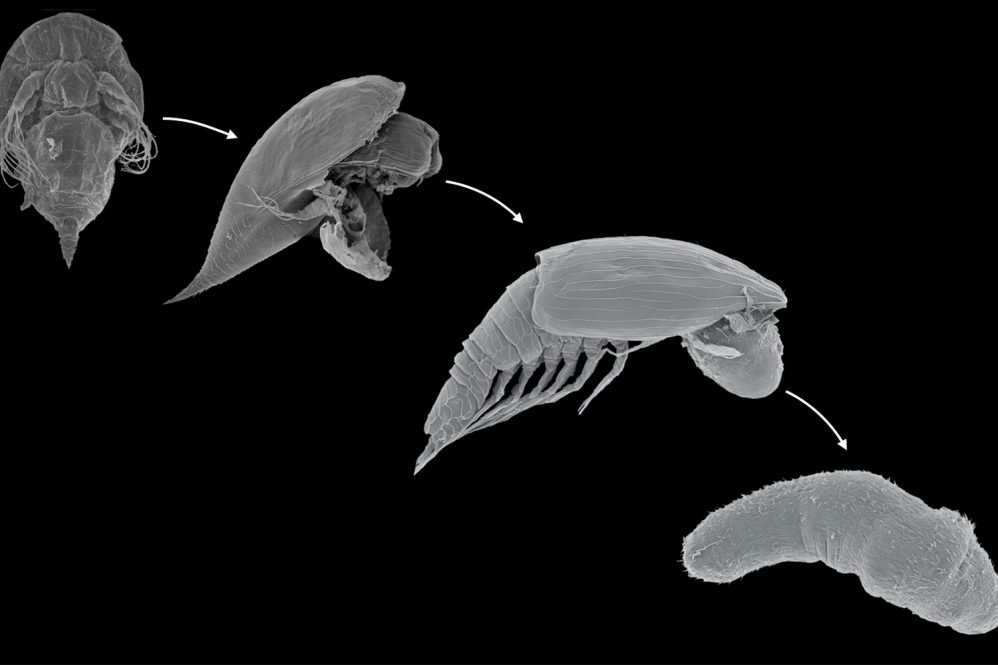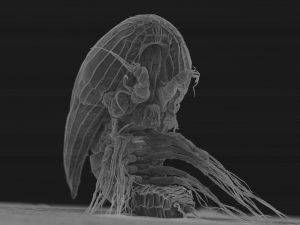Constructing the tree of life for parasitic barnacles and their relatives

This image shows the lifecycle of y-larvae from y-nauplius, to y-cyprid, to ypsigon (the last known stage), which is a worm-like stage that emerges from the previous larval stage if the y-cyprid is exposed to crustacean molting hormones. The researchers believet his worm-like stage is probably parasitic and would borrow into a host. Each is about 100 micrometers long (1/10 of a millimeter). (Image courtesy of Niklas Dreyer)
When you think of barnacles, you likely picture shell-like creatures stuck to the sides of boats or docks, or even whales. However, did you know that some of the barnacles that attach to other animals are not just hitching a ride — they actually hijack their host?
"Instead of gluing themselves to a rock or something, they glue themselves to a host, often a crab, and they inject themselves into that host, and live their entire life as a root network growing through their host. It's almost like a fungal network or plant root system. They have no real body in the way that we think of animal bodies," says UConn Department of Ecology and Evolutionary Biology Assistant Professor James Bernot.
Bernot and his colleagues – including lead author Niklas Dreyer from the Natural History Museum of Denmark and Biodiversity Research Center Academia Sinica, Taiwan; Jørgen Olesen at the Natural History Museum of Denmark; Gregory Kolbasov at Moscow University; Jens Høeg at the University of Copenhagen; and Ryuji Machida and Benny Chan at the Biodiversity Research Center Academia Sinica, Taiwan – published their research on a mysterious group of crustaceans in Current Biology (LINK) to hopefully solve an enduring puzzle about these strange creatures.
Bernot explains that barnacles are crustaceans, like crabs or shrimp, and they have evolved unique strategies for survival. For example, they go from a free-swimming larval form to live the rest of their lives permanently attached to their substrate of choice.
A particularly enigmatic group called "y-larvae," also known as Facetotecta, resembles young barnacles. Y-larvae have been studied in plankton samples since the 1800s, but Bernot says the real mystery is figuring out what they grow up to be-so far, the adult stage has never been seen. Though that element remains unanswered, in this new paper, the researchers are getting closer to finding out.
To look for clues on how y-larvae fit into the tree of life, the researchers collected more than 3,000 of the tiny crustaceans and analyzed their genes. They did this by sequencing the transcriptome, which is similar to a genome but represents the RNA that is expressed.

"We were finally able to confirm, in the realm of big data science, that they are, in fact, related to barnacles, but they aren't closely related to any of the other parasitic barnacles. This was interesting to test by building a giant tree of life for all the crustaceans, then adding this little branch of y-larvae , this very unknown group, to that bigger tree, and we saw that they are related to barnacles, but more as distant cousins," says Bernot.
Though not closely related to parasitic barnacles, these crustaceans are also likely parasitic because they have some structures in common with their parasitic cousins, says Bernot, including antennae with claws that may be used to hook onto their host.
"One of the best pieces of evidence we have that y-larvae become parasitic is that if we expose them to crustacean growth hormone, they will hatch out of their little swimming larval shape into a small slug-like body, which is similar to what parasitic barnacles do when they enter a host," says Bernot. "The fact that if we give them hormones, they also molt into a slug-like thing, suggests they go on to be parasitic somewhere, but we still don't know what host they end up in. Being hidden inside another animal's body could explain why we haven't found the adult stage of y-larvae yet."
Although these crustaceans are unusual and largely unknown with only 17 species described so far, Bernot says some of his co-authors found more than 100 new and different species from a single harbor in Japan. There is more to learn about these enigmatic animals.
"We know the other parasitic barnacles do weird things. The ones that grow like roots inside of crabs castrate their hosts, so their hosts are no longer able to reproduce. They trick their hosts into thinking that the host is pregnant, so it starts taking care of this mass that grows outside of its body, but that mass is part of the barnacle and not actually the eggs of the host, and even if they infect a male crab, the male crab becomes feminized and starts behaving like a pregnant female crab. Y-larvae could be having similarly impactful roles in ecosystems, but we won't know until we find what hosts they are living in and what they are doing there," says Bernot.
Since the y-larvae transcriptome sequencing showed they were not closely related to parasitic barnacles, Bernot says that it is likely that y-larvae and parasitic barnacles evolved in a process called convergent evolution.
"Because they're probably both parasitic and doing similar things, they've evolved similar strategies to attach to a host and to become this slug-like larva. It's amazing to think that that really weird, unique lifestyle evolved multiple times."
Different species of barnacles use different strategies when they become sessile adults. Besides living on inanimate objects, those that live on animals like whales are not considered parasitic because they are essentially hitching a ride and do not feed on their host. Others attach to the host and have structures that they use to feed on the host. Understanding the evolution of these different strategies is important, and Bernot says that a project they are currently working on involves building the evolutionary tree of all barnacles to observe and understand some of the evolutionary patterns.
"A big question is, what is it about barnacles that has given them so much variability over evolutionary time to take on so many different shapes and forms and lifestyles? They have come up with incredibly ingenious strategies for making their ways of life, and often their ways of life seem very bizarre to us, but they have clearly been very successful," says Bernot. "These animals have been around for hundreds of millions of years and there are several thousand species of them, so they have come up with some really amazing solutions to complex problems."
Some of those solutions could also help humans. For example, Bernot says, there is a lot of interest in trying to better understand barnacle glues.
"They glue themselves to docks, they glue themselves to boats, and that is a problem. The Navy spends millions of dollars on additional fuel because barnacles on their ships cause additional drag. Also having more powerful glues that can dry underwater would be very useful for mechanical reasons, but maybe also for dentistry and things like that," says Bernot. "There could be a lot of applications if we can better understand some of these amazing solutions that barnacles have evolved."






